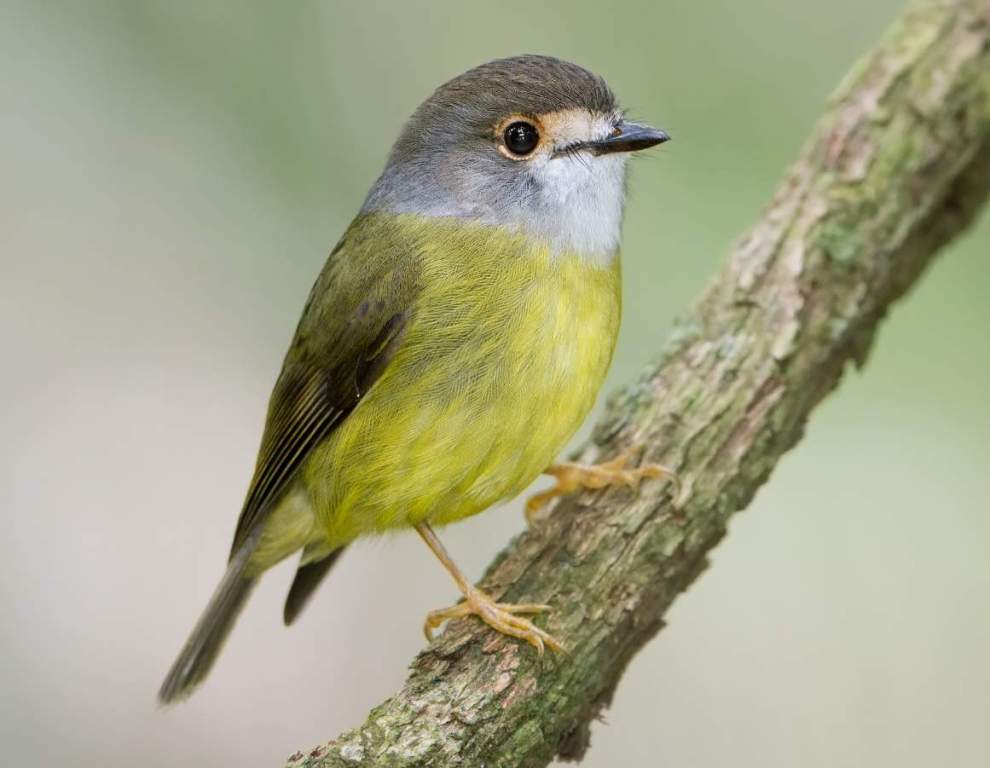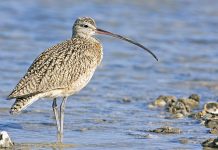Habitats: Pale-yellow Robin (Tregellasia capito) habitats are located along the central and northeast coasts of Australia in upland subtropical rain forests. The species perches and pounces through the lower and middle stages of the rain forest to forage.
Sitting still and silent on a low branch within six or seven meters of the ground, often hanging sideways on vertical trunks or saplings, it watches down and around without flicking its tail or wings. The pale-yellow robin is a sedentary bird. It appears that established pairs maintain the same small area of a few hectares throughout the entire year.
While seen as solitary, they may tolerate other members, perhaps their young from previous seasons. There are significant differences between the Pale-yellow Robin and its close relative, the White-faced Robin, despite their similar coloring and habit of sitting sideways on vertical stems. The flycatcher-like bill of this bird is rather flat; the fledglings are a plainer reddish brown than those of whistlers; the nests are adorned with lichen flakes rather than strips of bark; and at rest, they don’t raise their tails.

Pale-yellow Robin vs. Eastern Yellow Robin – In comparison to Eastern Yellow Robins, Pale-Yellow Robins are smaller, have olive-colored upper parts, pale faces, and pale yellow underparts, and lack pale eyebrows.
Foods: As soon as it sees prey, it dives down onto it, which may be lying on the ground, fallen logs, trunks, or low foliage. A robin may also flutter out on its wings at times to catch insects in midair with its flattened flycatcher-like bill. Beetles, ants, flies, and spiders make up the bulk of their diet.
Alternative Names: The bird is also known as Pale Robin and Rufous-lored Robin.
Size: Approximately 120-135mm is the length of the Pale-yellow Robin.
Identification: Both sexes share similar characteristics. Coverts on the crown and ears are dark grey-brown, grading to dull olive-green on the back, shoulders, and rump. Dark grey-brown wings and tail with olive edges. Lords are buff (in the northern race) or white (in the southern race); the chin and throat are white; the rest of the underparts are dull yellow. The eyes are dark brown. Black bill; dull buff base to the lower mandible. Orange-yellow is the color of the feet.
Immature birds are usually plain russet-brown in color. There are dusky and rufous mottlings on the head; the feathers on the back, shoulders, and wing coverts are ginger-red; the underparts are dull yellow-cinnamon, and the feather tips are rufous. The juvenile plumage molts out within a month of fledging.

Call: Pale-yellow Robin calls are short single or double squeaks, by both sexes.
Song: However, the song is a soft churning trill in the display of territorial defense; harsh scolding scarier by male, in alarm or maybe territorial advertisement.
Nesting & Breeding: Breeding and nesting take place between July and January. This nest is made from bark strips, dried leaves, and fiber, bound with cobwebs. Usually placed in an upright fork in a thin sapling, bush, or lawyer vine, it is covered with lichen, bark, and moss on the outside and lined with softer fiber on the inside. The nest is made between 1 and 10 meters above ground. There is some evidence that these birds may assist the dominant pair in feeding the young, but it is likely that only the female nest builds and incubates; the male feeds her on the nest.
Eggs & Incubation: There are two eggs laid by a pale-yellow Robin; they are lustrous, pale green, freckled with yellow-brown to chestnut, dotted with grey spots, particularly at the larger end, where zones may form; they are oval, about 20 x 16 millimeters. The female is probably responsible for incubation.
Distribution: The bird is endemic to Australia. Two tracts of the Pale-yellow Robin are found in subtropical and upland rain forests: one between the Hunter Valley, New South Wales, and Mary River, Queensland, and one between Helen Vale and Mt Spec, Queensland.
Races: In each tract, there will be two races.
Family: It is a species of passerine bird in the Petroicidae family.







